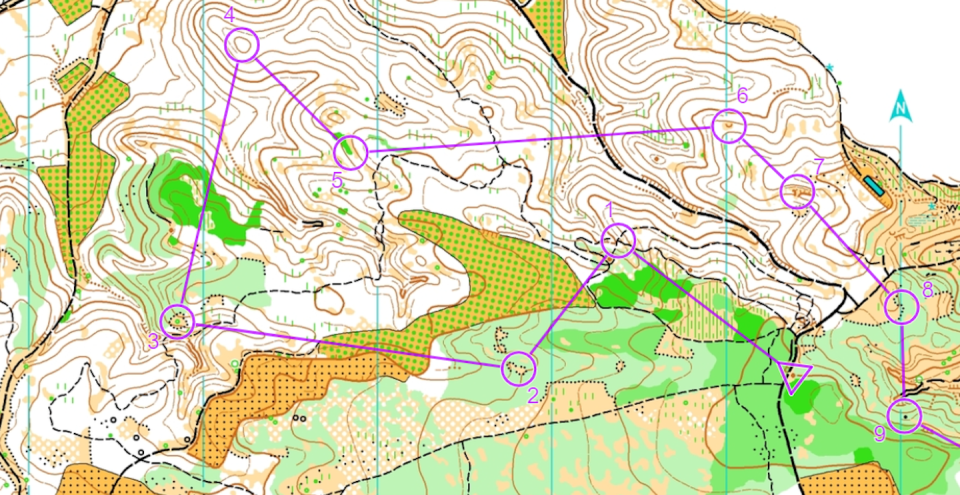For all ages and physical conditions
Sports orienteering emerged in Sweden in the late 19th century with the advent of topographic maps as a form of military training to improve autonomy.
Today it is an endurance sport usually practiced in natural environments, although trials are also held in towns or cities. The streets of Venice or the shopping centers have been some of such scenarios.
Athletes must travel through a series of points marked on a map to a location previously unknown to them, taking as little time as possible. These cartographic points are found on the ground as orange and white lights. The only aids available are a compass and an electronic card to record your route through checkpoints.
The orientation map is specially designed for these tests and has special features of colors and symbols.


The tests are divided into categories according to gender and age, with a five-year range depending on the test. The routes are fully adapted to each category of difficulty and physical toughness.
And this is actually one of the strong points of the orientation: anyone, regardless of their age or physical condition, can participate. Therefore, it has emerged as a very suitable option to promote sports practice among older people and a family. In a test we can find everything from small children running alone in the mountains to experienced participants who go more slowly but read the map better than young people.
On foot, by bike, on skis…
There are different types of sports orienteering, with different travel formats:
-
Walking Orientation (O-PIE), The practitioner looks at the points while running or walking.
-
By mountain bike (MTB-O), We can only move on existing paths or paths, unlike foot orientation, in which the athlete can go wherever he wants.
-
Ski Orientation (SKI-O)Practiced in the snow with cross-country skis.
-
adventurous raid, They combine different adventure disciplines (MTB, mountaineering, climbing, kayaking, archery…) leitmotif Of orientation.
-
rogening, They are long-term tests (6, 12 or more hours) in which participants (grouped in pairs or teams) must find the maximum number of control points, scoring them according to difficulty.
-
trail-o, Adapted option for people with reduced mobility. Here time is not counted, but the degree of accuracy when identifying the location of control points.
physical and cognitive benefits
Sports orientation can be considered a very complete sport, since in it physical performance factors such as endurance – these are long-distance running – are combined with agility and coordination, as they develop in a natural environment, rather than in traditional Off track.
Furthermore, cognitive skills play a fundamental role in reading a map, planning a route, memorizing, identifying map elements on the ground, making decisions… It is not enough to just run around like a headless chicken. Additionally, the consultant must be adapted to terrain conditions, weather, and other non-controllable factors, which enhances his ability to respond.
Read more: Why does traveling to the countryside take over our minds?
Regarding scientific evidence, various studies show that the practice of counseling improves the quality of life in older people. Furthermore, it has been proposed as an intervention to prevent cognitive decline in this population group, improving memory protection and mobility.
great family of orientation
Secondly, as we have already mentioned, it is a very familiar sport that can be practiced even by people with reduced mobility. Socialization among participants is inherent in this discipline.
For the little ones it is an adventure that enhances spatial orientation, autonomy and decision making. And, of course, it provides everyone with complete immersion in nature.
Given its benefits at the physical and cognitive level, and without forgetting that it is also a lot of fun, we invite you to try the sport of orienteering and put aside the fear of getting lost, pardon the exaggeration.
This article was originally published on The Conversation, a nonprofit news site dedicated to sharing the ideas of academic experts.
Read more:
Ana Vanessa Battler Cervero receives no salary, nor does she do consulting work, nor does she own shares in, nor does she receive financing from, any company or organization that could benefit from this article, and she declares That he/she has no relevant links beyond the above mentioned academic status.
(TagstoTranslate)ControlPoints
Tags Orientation Spanish Orienteering Federation
Check Also
SAVALNET – Science and Medicine
Several studies have linked dietary factors such as caffeine, fish and vegetable intake to risk. ... Read more
 Play Crazy Game Trusted Gaming News Portal
Play Crazy Game Trusted Gaming News Portal



